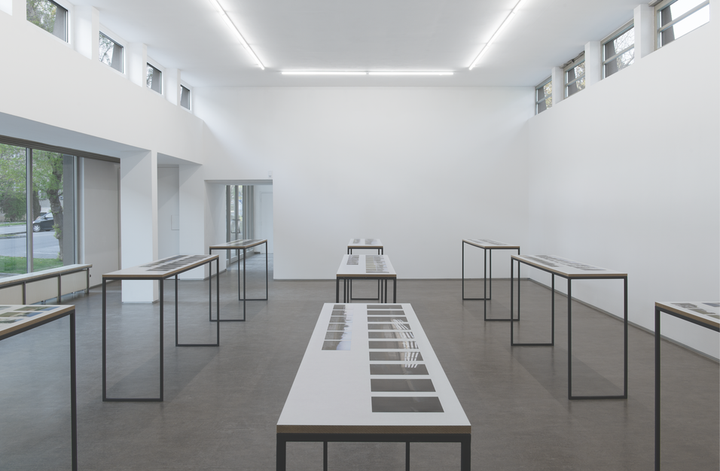Krems. If you are familiar with filmmaker and artist Josef Dabernig’s work and with exhibitions organised by David Komary, Galerie Stadtpark’s director, you will be aware that they have a few things in common: that includes precision and a strong sense of structure, along with a predilection for emptiness. Dabernig’s one-man show at mumok, where his white projection booths vanished visually into the White Cube, was entitled Rock the Void. Similar comments could be made about David Komary’s exhibitions: Josef Dabernig’s Equally Not Nothing in the Krems exhibition space slots into a whole series of presentations in which often very little is visible from the outside despite the huge window panes.
In Josef Dabernig’s show, viewers first of all see a minimalist grid of nine display case frames, three standing side by side, with three rows lined up behind. Each showcase contains two series from Dabernig’s panorama collection, each containing a number of photographs. On the top, there is always a nine- to ten-part series in portrait format (13 x 18 cm), while below a shorter, usually six-part, series in landscape format (10 x 15 cm) is on display.
Viewers are supposed to move slowly from image to image, from showcase to showcase, and thus, as it were, physically retrace a camera track in order to reassemble in their mind’s eye the horizontally conceived “all-round photographs” that Josef Dabernig teases out still further by introducing a gap between the images.
The subject-matter is empty football stadiums, which the artist has been photographing in the same way since 1989 (it is no coincidence that this was the year the Berlin Wall fell). Starting from the centre, he shoots individual images; due to the sheer size of the stadiums, a panorama of these huge architectural structures is only possible by depicting a number of fragments. In this case, the photos show sports grounds in Rijeka, Pula and in the two Armenian towns of Mezamor and Kapan, which the artist photographed in this special, “manual” mode. Overlaps and missing sections are almost inevitable with this method, while the individual photographs are not perfect either. Sometimes too dark or out-of-focus, they are in marked contrast to the glossy photographs every smartphone can take today.
Josef Dabernig of course has as little interest in digital correction as in seamless connections between the images. On the contrary: as the images are taken as individual shots, each of the up to ten photographs focuses in a sense on its own centre. There are consequently ten individual centres rather than the single centre-point to which the architecture actually directs our gaze.
The deconstruction of the arena as “viewing machine” (Dabernig) is very subtle, while the presentation also decelerates the reading of the images, bringing us to another aspect the artist and curator have in common: both are far removed from Instagram-style rapid scrolling through images. Their focus is on slowing down and concentrating the gaze, which Dabernig also achieves through repeated viewing, re-presentation, and ever-so-slightly shifted framing and re-positioning of his panoramas.
Given his interest in how the gaze is directed, it is in addition almost self-evident that Dabernig is also always looking back over his shoulder. Earlier, in his film Wisla (1998), he had already directed the camera away from the pitch and towards two coaches commenting on a game, while in the display cases in Krems there is also always a “reverse shot”, in other words, the potential second panorama located, so to speak, behind the stadium that is spread out above.
While Dabernig’s juxtapositions echo real-world parameters, he also adheres to principles of montage, meaning that the counterpart to the suspension bridge shown in Hängebrücke zum Gandsassar Stadion in Kapan (2017), for example, is an interior, namely the Panorama der Lobby im Hotel Darist in Kapan (2017).
This constant, illuminating switching between the perceptual dispositives of film and photography is addressed immediately at the entrance to the exhibition. That is where the film WARS (2001) is presented and traces out a trail from train travel via film to the photographic panorama. For this early black-and-white 16mm film, Dabernig chartered a train that travelled from Krakow to Warsaw and back. With this setting, Dabernig returns to the early days of film, although the focus is not on the landscape passing by, i.e. a sequence of images, but on an (almost) static shot of a restaurant car. The bored waiter and waitress have no guests yet, the cook glances out of the window. Time almost seems to stand still in the rattling train, until the three of them fling themselves into cleaning the train in a sudden flurry of activity.
Absurdly funny moments like these crop up in all of Josef Dabernig’s films, in which Socialist-era modernist architecture and aesthetics also play a decisive part, ranging from trains or hotels to amusement arcades or even sports arenas, which Dabernig, an avid football fan, also visited time and again in the East. His particular approach to photographing them reduces the impact of this overwhelming architecture to a tolerable level; rather than feeling as if they are standing in the architecture when viewing his panoramas, viewers can look very soberly at the alluring structures as a dispositive of power and spectacle.
Translated by Helen Ferguson
